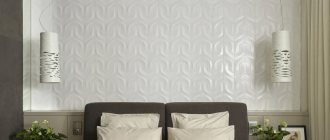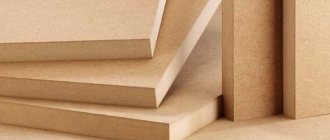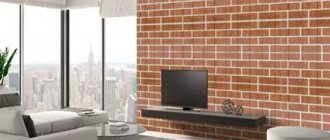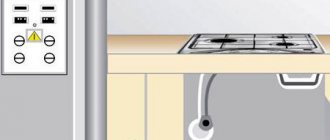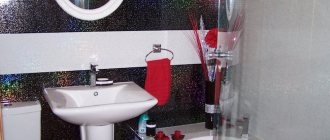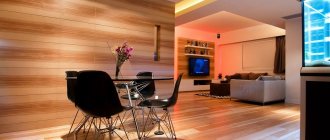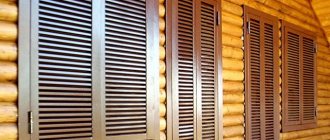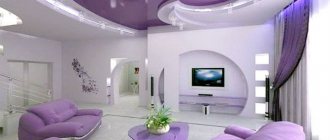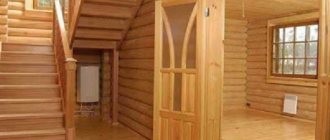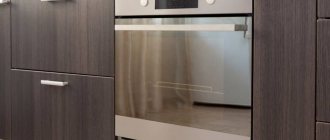Historical background
Panels have been used in residential spaces since before our era - for example, in Ancient Egypt. However, they found widespread use in France, Italy and England during the Renaissance (XIV-XVI centuries). In addition to decorative functions, the panels also had many utilitarian properties: they helped retain heat, soundproofed the spaces of large halls of palaces, and sometimes hid secret staircases and secret rooms.
Wall decoration in modern interiors
The most important task of a modern designer is to create a project concept and follow a style that is close to the customer. The choice of panels, which must correspond to the historical style - baroque, rococo or the classicism, empire style, art nouveau and art deco that replaced them, also depends on this.
In styles such as eclecticism, minimalism, fusion, boho or Provence, wooden panels (or their imitation) become the basic architectural element that ties the space together. Wooden decorative trim becomes the backdrop for the furniture and accessories that fill the room. Built-in furniture, cabinets and display cases, doors and door portals that “grow” from the panels or are hidden behind them, as well as ceiling decoration and cornices - all this is also directly related to the design of the walls.
Types of wood wall panels, material advantages
In the catalogs of leading manufacturers you can find stacked types of lamellas. They are quite acceptable for cladding a small room. Outwardly, they resemble narrow lining, and are connected using a tongue-and-groove pattern end-to-end or groove-inlay - in the latter case, a gap is formed, which can become part of the decor or can be closed with a special profile.
Also interesting are the variations of tiled - square and rectangular - panels, from which ornaments or complex compositions are often laid out. Such segments are famous for their wide variety of shades and textures.
Large decorative wall panels make DIY decoration easy. Manufacturers produce design options that imitate stone, mosaic and other spectacular structures. The seams formed during installation are usually covered with moldings.
Wooden panels may differ in the manufacturing method:
- Massive solid natural panels. The most commonly used wood is oak, alder, cedar, maple, and walnut. Expensive and respectable specimens are suitable for status rooms and offices. In case of high humidity, a wax coating is used. There are stylized modifications: for example, painted oak veneer panels imitating elite mahogany.
- Democratic adhesive types of such finishing material are more common. They are easy to install with your own hands; such cladding looks stylish and presentable.
- Derived wood-shaving options - chipboard, MDF - are available to a wide range of consumers, made by pressing chips and sawdust. They are designed for dry rooms and cannot withstand high mechanical loads. The less durable chipboard sheet contains additional plant fibers.
All types of panels are environmentally friendly, and such cladding will provide good insulation. Wooden cladding also has a number of advantages:
- The breathable coating has hygienic certificates, helps create a pleasant microclimate, and does not interfere with natural air exchange.
- Modern products are protected by coatings with an antistatic effect, which makes cleaning easier.
- Wall structures made of aesthetic material can be assembled with your own hands, following certain algorithms.
Designers highly appreciated the properties of natural materials, and manufacturers maximized the variety of types. Therefore, any consumer can decorate rooms, hallways, and offices in the desired style, guided by expediency and their own imagination. Decorating walls with wood panels is fashionable, practical and modern. “Play” of colors, original drawings applied to the protective film, or 3D compositions will look very non-trivial.
Types of panels
Boiserie and Wainscot
Decorative wooden boiserie panels most likely appeared in France - in any case, it was there that they were once given such an elegant name. In the castles of the French nobility, luxurious floor-to-ceiling wooden walls appeared in the 17th century. English Wainscot is more laconic - usually it is oak panels without patterns or carvings, which were used to decorate only the lower part of the walls.
Both methods of wall decoration are still in demand today. Decorative panels are made to order according to old or new drawings, and antique dealers offer wooden trim pieces from old French houses.
Wooden 3D panels for walls
Relief (three-dimensional) wood panels are a finishing material that is structurally reminiscent of a mosaic. Each of its elements is part of a specific design, ornament or geometric pattern, and by putting them together, you can get interesting textures and optical illusions.
Such panels are rarely used to decorate the entire room - usually we are talking about one accent wall or even part of the wall, which serves as a panel or a bed headboard.
Slatted panels
Decorating a wall or part of a wall with slats is another popular way to decorate a modern interior: it is economical, effective and stylish. As in the case of 3D panels, slats rarely decorate the entire space - as a rule, they are used when it is necessary to visually zone a room.
MDF panels
Perhaps the most budget-friendly and easiest-to-install option is MDF panels. Small wood chips are thermally treated and pressed under high pressure, without adding toxic resins and adhesives, as in chipboard. This makes MDF sheets an environmentally friendly and inexpensive material.
Today, when the “craft” eco-style with its characteristic shades of wood and corrugated cardboard is at the peak of popularity, designers are increasingly turning to MDF panels, showing that stylish does not have to be expensive.
Mounting options
Wooden smooth panels for walls Wall panels made of natural wood from floor to ceiling
Installation of wooden panels for walls with the bottom chord
Wooden wall panels in a checkerboard pattern
They trust us
Reviews and diplomas
Trends
- Today the direction of “new reading of the classics” is developing. For example, historical decor in the Baroque style is recreated on MDF panels, after which each panel is painted in one, often very unexpected color - for example, deep ultramarine, dusty pink, delicate mint or French gray.
- Another technique that allows you to create non-standard interiors at the intersection of classic and modern is the combination of historical boiserie with ultra-modern pieces of furniture and abstract painting.
- If the interior tends towards Art Deco, finishing finishes will come to the rescue, as well as combinations with elements made of brass, glass, leather and enamel.
- The texture of natural wood is one of the main global trends in interior design. To highlight the natural beauty of veneer, you can treat it with oil impregnations: they will help preserve the color of the wood or give it the desired warmth.
Source: pinterest.com
The wall at the head of the bed is increasingly being decorated with wood
Source: kinfolks.info
Source: pinterest.ru
Source: apartmenttherapy.com
Design
Custom-made wooden wall panels can be perfectly combined with other materials. For example, it could be: decorative wallpaper, plaster with various effects, inserts made of leather, fabric or glass. In a classic-style interior, solid oak wall panels are often decorated with carvings, milled pilasters, patina or gold leaf (which emphasizes the beauty of carved elements and figured profiles). For modern models, a minimum number of decorative elements is used; simple, geometric shapes, natural shades of natural wood, dark or light tinting, staining or a light solid coating predominate. We produce custom-made wall panels from natural wood of any complexity and in the desired style.
Examples of finishing wood panels
Custom panels for any interior
Design of solid wood wall panels in a modern style
Wooden wall panels in classic style to order
Wall panels made of wood with a custom design (built-in shelves for books)
Trends in wall decoration with wood panels
In the decoration of expensive interiors, preference is increasingly given not to classic decorative elements (carvings), but to more modern ones: inserts made of brass, glass or natural stone.
Simplicity and laconic forms are in fashion, which can be embodied in the straight (flat) design of wall panels made of natural wood.
Wooden panels with visible texture in the interior are a trend that will not lose its relevance for many years. Send a request
Catalog
Popular materials
Historically, the most common type of wood for interior wall decoration is oak. American and European walnuts are also often used. For carved parts, softer species are chosen - for example, linden and ash.
In refined and luxurious styles (such as art deco or classic), it is customary to use more valuable, rare, and sometimes exotic wood species: bird's eye maple, rosewood, Macassar, sycamore, black plane tree, wenge.
If we add to this various types of wood veneer finishes (matte, gloss, tinting with tint varnish, painting, aging, painting or gold leaf), you get a huge number of types of wall panels that can satisfy absolutely any request.
The service life of natural wood panels with proper care is very long, and the coating itself can serve for several generations, turning the house into a family nest. MDF panels covered with topcoat varnishes will also last a long time: they will not be subject to changes in humidity and temperature in the room.
Why choose our wall panels?
Quality.
Manufactured in production with modern equipment and strict quality control.
Individual solutions.
Any size, design and finish.
Environmental friendliness.
High-quality and natural materials.
Manufacturing from solid wood of valuable species, MDF, exotic veneers (roots, wenge, etc.). Modern technologies.
Painting and finishing using Italian technologies: a pleasant-to-touch surface without defects, comparable to high-quality expensive furniture.
Guarantee.
We provide a quality guarantee of up to 3 years. Send a request
Catalog
We produce wooden wall panels for interior decoration from high-quality materials (oak, wenge, walnut, German veneered MDF and others), with any design and finishing in the best Italian traditions. They are suitable for a bedroom, home office, office, billiard room, hallway or other premises - the scope of wood wall panels for interior decoration is limitless.
Public VS living spaces
There is an opinion that wooden panels are used mainly in commercial premises - offices, studios, restaurants. However, Alexander Evdokimov assures: more than twenty years of experience indicates the opposite. Panels, like built-in furniture, are very often used to decorate the space of home theaters, living rooms, bedrooms, dressing rooms, kitchens, corridors, halls and even bathrooms. Today, when Art Deco and new classic styles are at the peak of popularity, wooden wall panels are especially in demand in residential interiors.
“As for offices and meeting rooms in offices, this is also relevant,” notes Alexander. “Respectable businessmen and gentlemen have always preferred interiors with wood paneling, which maintain an atmosphere of trust and cozy luxury.”
Panel care
Caring for wood panels is no more difficult than caring for parquet. If the tree has initially undergone a technologically correct drying and storage procedure, then the owners of premises with such decor can only monitor changes in humidity, and in winter, during the heating season, use air humidifiers.
Do not rub the panels with chemical polishes - it is enough to remove dust with a cloth rag using non-aggressive liquids.
